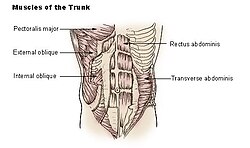Transverse abdominal muscle
| Transverse abdominal muscle | |
|---|---|

Muscles of the trunk.
|
|

|
|
| Details | |
| Origin | Iliac crest, inguinal ligament, thoracolumbar fascia, and costal cartilages 7-12 |
| Insertion | Xiphoid process, linea alba, pubic crest and pecten pubis via conjoint tendon |
| Artery | subcostal arteries. |
| Nerve | Thoracoabdominal nn. (T6-T11), Subcostal n. (T12), iliohypogastric nerve (L1), and ilioinguinal nerve (L1). |
| Actions | Compresses abdominal contents |
| Identifiers | |
| Latin | Musculus transversus abdominis |
| TA | A04.5.01.019 |
| FMA | 15570 |
|
Anatomical terms of muscle
[]
|
|
The transverse abdominal muscle (TVA), also known as the transverse abdominis, transversalis muscle and transversus abdominis muscle, is a muscle layer of the anterior and lateral (front and side) abdominal wall which is deep to (layered below) the internal oblique muscle. It is thought by most fitness instructors to be a significant component of the core.
The transverse abdominal, so called for the direction of its fibers, is the innermost of the flat muscles of the abdomen, being placed immediately beneath the internal oblique muscle.
The transverse abdominal arises as fleshy fibers, from the lateral third of the inguinal ligament, from the anterior three-fourths of the inner lip of the iliac crest, from the inner surfaces of the cartilages of the lower six ribs, interdigitating with the diaphragm, and from the thoracolumbar fascia. It ends anteriorly in a broad aponeurosis (the Spigelian fascia), the lower fibers of which curve inferomedially (medially and downward), and are inserted, together with those of the internal oblique muscle, into the crest of the pubis and pectineal line, forming the inguinal conjoint tendon also called the aponeurotic falx. In layman's terms, the muscle ends in the middle line of a person's abdomen.
Throughout the rest of its extent the aponeurosis passes horizontally to the middle line, and is inserted into the linea alba; its upper three-fourths lie behind the rectus muscle and blend with the posterior lamella of the aponeurosis of the internal oblique; its lower fourth is in front of the rectus abdominis.
...
Wikipedia
